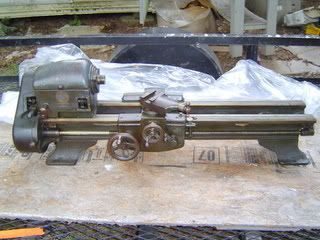exkenna
Stainless
- Joined
- Nov 29, 2007
- Location
- North Alabama
Finally found a nice little lathe: a mid 40's (I think) Montgomery-Ward in great shape. Came with the old heavy chip tray and cast iron leg set, all in great shape.
It looks like the original paint. There are some places where the paint is worn through and looks like burnished metal underneath.
What's the best way to get all the paint off without using any kind of immersion method? I have read post where someone used a turkey fryer and boiling TSP water to get it off. I don't have a fryer and I'm hoping not to tear this thing down that far anyway. No need to.
I would like to do small areas at a time using chemical paint stripper.
Can you suggest one that really works? Most I have tried on household projects sucked.
The pics make it look worse than it is, I think partly because of the color.
That's not rust you see. I sprayed it down with CRC corrosion inhibitor to get it home. It turns kinda waxy brown after it dries.
I think this is a Logan but can't find much about it.

It looks like the original paint. There are some places where the paint is worn through and looks like burnished metal underneath.
What's the best way to get all the paint off without using any kind of immersion method? I have read post where someone used a turkey fryer and boiling TSP water to get it off. I don't have a fryer and I'm hoping not to tear this thing down that far anyway. No need to.
I would like to do small areas at a time using chemical paint stripper.
Can you suggest one that really works? Most I have tried on household projects sucked.
The pics make it look worse than it is, I think partly because of the color.
That's not rust you see. I sprayed it down with CRC corrosion inhibitor to get it home. It turns kinda waxy brown after it dries.
I think this is a Logan but can't find much about it.



